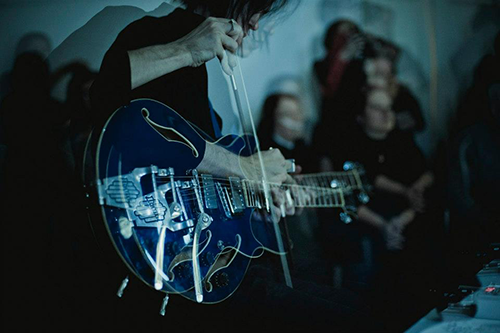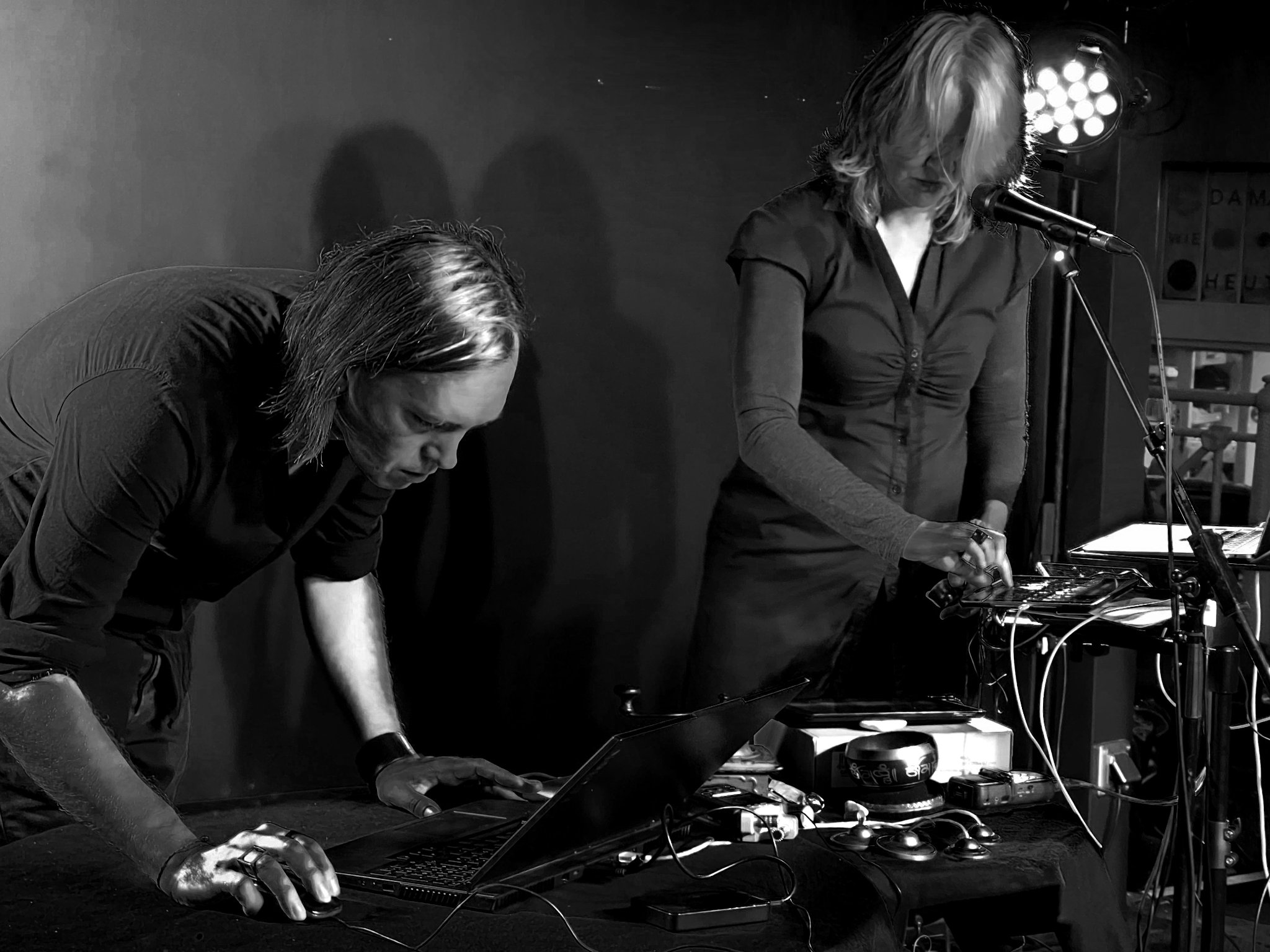FLOATING SOUND GALLERY
Vienna
Patrick K.-H.
Sound- / Video- / Visual artist
Patrick K.-H. (aka Anton Iakhontov) collages within the fields of sound installations, live and tape acousmatic and animation, exercising cross fertilisation.
Author of music / video for opera / drama / contemporary dance / post-dramatic theatre plays and performances as well as his own works in Russia, Austria, Germany and USA. He has had his music, video and performances presented in more than 200 festivals and series around the world, holding several international awards. In 2009, he created sound-scape for Russian pavilion of 53rd international art exhibition la Biennale di Venezia.
Head of media research programs of Media-Studio at the New Stage of Alexandrinsky Theatre, St. Petersburg. Founder (2008) and co-curator (since 2010) of the Floating Sound Gallery – the sole venue for spatial sound in Russia (currently in St.Petersburg), organiser and curator of festivals and educational programs, among them – Russian “ACOUSMONIUM inauguration” (since 2018).
Resides and works in Vienna and elsewhere.
Listen + connect:
︎ ︎ ︎
Compositions / Works
postard 02, 06’ 24’’, 2021-2023
Presented within Circuit Fantôme Season 3 Episode 1
postard 00, 03’ 06’’, 2021-2023
Presented within Circuit Fantôme Season 3 Episode 1
postard 08, 04’ 41’’, 2021-2023
Presented within Circuit Fantôme Season 3 Episode 1
postard series realised with the support of Stadt Wien Kultur

fwer, 2023
Presented within Acousmonium 2023
postard 01 (Intro 4), 03’55’’, stereo, 2021-22
Presented within Circuit Fantôme Season 1 Episode 8
postard 04 (Waltz 22), 03’48’’, stereo, 2021-22
Presented within Circuit Fantôme Season 1 Episode 8
postard series realised with the support of Stadt Wien Kultur

“postglacial”, live performance - together w/Martina Claussen / 2022
Performance took place 07 August, 2022 at Naschmarkt / Kultursommer Wien 2022






Find out more about the project here
5 Levels, 18’44″ / 2022
@Superspreading Art
A cooperation between:
Axel Dörner: trumpet & electronics
Patrick K.-H.: video & audio electronics
Katharina Klement: zither, objects, electronics
The idea of the work arose on the one hand from the consideration of dealing with the media music and video on an equal footing, and on the other hand I wanted to work with artists I had on my wish list for a long time, but who were not easily accessible for direct collaboration due to their distant place of living. Berlin with Axel Doerner, St. Petersburg with Patrick K.-H. and Vienna with me were our geographical axes at the beginning, and from March 2022 Patrick came entirely to Vienna, where he already had a foothold anyway, due to the Ukraine war. In five successive steps, audio and video material was generated in a ping-pong process, it was reacted to, then mixed, overlaid, interpreted and transformed. In the last step, the resusts were sifted through again, reduced and put together into a whole. As chance would have it, there were also five sections on the temporal level, which can stand on their own or be read as a sequence with references to each other.
Katharina Klement, May 2022
Find out more about the project here
fwer, 2022
(from fear, fewer) departs from Patrick K.-H. cycle of William S. Burroughs works (along with “Most Natural Pain” 2016 and several live acts). “Fear of death is form of stasis horrors. The dead weight of time.”
Words getting lost in music composition.
AorA, 3’22“ / 2020
an adjacent piece, a splinter that departed from the main body of “Concrète choirs” in search for its own way in life.
Concrete choirs, movement 2020 (17’30“)
Language is what makes conversations possible, and conversation is a quintessence of social activity, meaning survivorship—it is a cliché of what language meant to be and how it paved its way to nest in our brain. Electronic media and the new paradigm of “information explosion” that characterizes our times confront us with the limitations of the brain in processing information—indeed we suffer from information overload. But the bigger danger of information—what causes the infamous “paradox of rational ignorance”—is not only that we might be overwhelmed by how much data is, but that we interpret that we might be poisoned by it. And even if we could acquire as much information as we think we desire, there are certain sequences, messages and narratives a rational mind may not be willing to get. That “cursed” domain of language information presented in speech, which carries its traits of timbre, tonality, rhythm, linguistic, gender and other aspects classified as redundant, was adopted as sound objects—building blocks to constitute the “Concrète choirs”.
Drawn sound performances since 2010
“Drawn Sound” is both an audiovisual performance and an open composition.
It examines new values of one century old – and then-groundbreaking – technology of drawn, also known as graphical, sound. The latter, emerged nonlocally through heuristic inventions of artists and technicians acquired with film technology, in most of the times pursued a goal of creating impossible sounds, sounds that don’t belong to any of the existing categories available through live performance or sound recording. This brilliant though highly resource-intensive task later nearly died death with the rapid evolution of synthesisers that delivered the promise of sound variety with less blood and sweat.
Patrick K.-H. and Oleg Makarov recreate this old-school yet ever-green approach – converting sound to image (that is graphical spectrum of sound), and back, image (sound spectrum) to sound – by nowdays’ means: Max/MSP/Jitter, cameras / lenses, video projection, spatialized sound. In their “Drawn Sound”, sonorities, sequences, phrases come to life through placement of a paint brush, which act somewhat like filters, extracting sounds from the solid colour of underlying white noise. The classical idea of drawn sound techniques happens to reveal much about possible contemporary approaches to music composition and its relation to unconventional instruments and performance.
pt.4 09:52
2021
realised with the support of Stadt Wien Kultur
pt.3
2019
realised with the support of SKE / austro mechana
pt.1 (24:44)
Patrick K.-H. edition 2016.
Patrick K.-H. / Burkhard Stangl / Thomas Gorbach, Acousmonium with prepared guitar edition 2018.
“Mutanys” series / since 2016
As the title suggests, the series is largely about mutations – to confirm this intention, mutation starts with the very orthography of the title.
A pivotal period of music history and theory was the beginning and middle of the XX century with its burst of music evolution theories, followed by biology-like mutation theories. Alike pre-darwinians, music people for centuries used to think that every music entity—be it genre or instrument—could be defined by a set of necessary traits that characterised its essence—that there was a precise definition for orchestra, opera, guitar, vocal, score, etc. (and of course there are “creationists” in music in now days). According to this “music creationism” paradigm, a guitar has a guitar essence—as well as music forms it would constitute—and can no more evolve into a squeak or murmur than a dinosaur can evolve into a bird.
One of conceptual breakthroughs that comes out of sound synthesis married to sound recording was the appearance of intermediate forms that are literally neither guitar nor murmur. Moreover, the mutants of that kind can vary in their qualities, and the variety of that qualities can suggest search of new music forms, stranger than ever existed.
The evolution of “Mutanys” had a winding path—prepared electric guitar later filtered and processed by graphic sound software, mixed into stereo, quadro, octophony and Acousmonium versions.
Ars Electronica afterlife
an untiled multichannel composition, originally performed @ Ars Electronica, Post City, Linz, Austria, 4.09.2015
Dead Score, 6-channels, 2015
“Dead Score” simulates a situation of a stranger in a country which language (s)he doesn’t speak. For such person, it takes no time to succeed at understanding that a) what (s)he hears is language and not anything else, and b) nearly all what (s)he learnt as “language” is right now a dead-weight. Each conversation quickly comes as rejected invitation to participate in meaningful information exchange, the one becomes compelled autist. Helplessness provokes to grasp whatever possible – and the one starts picking out blocks of organised sounds, perhaps with the same lack of mastery. Within seemingly undoubtful finite number of elements, (s)he tries to form valid generalizations, but empirical constraints filter out the unknown concrete meanings towards the condition of abstract sounds.
Dissimilate pt. 2, 16-channels /2015
Room Sketch: Dada Sonic Sculpture (w/ Oleg Makarov), mechanical sound installation / 2014
Room Sketch: Sonic Relay live (w/ Oleg Makarov), laptop, Max/MSP, Arduino, relays / 30.05.14
Concrète choirs series (since 2004)
Language is what makes conversations possible, and conversation is a quintessence of social activity, meaning survivorship—it is a cliché of what language meant to be and how it paved its way to nest in our brain.
Electronic media and the new paradigm of “information explosion” that characterises our times confront us with the limitations of the brain in processing information—indeed we suffer from information overload.
But the bigger danger of information—what causes the infamous “paradox of rational ignorance”—is not only that we might be overwhelmed by how much data is, but that we interpret that we might be poisoned by it. And even if we could acquire as much information as we think we desired, there are certain sequences, messages and narratives a rational mind may not be willing to get. That “cursed” domain of language information presented in speech, which caries its traits of timbre, tonality, rhythm, linguistic, gender and other aspects classified as redundant, was adopted as sound objects—building blocks to constitute the “Concrète choirs”.
Concrète choirs: “Overtranslation” movement 2, 05’09″ / 2004-2008
